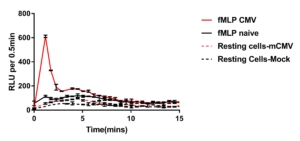How latent viruses may contribute to acute lung injury
Author(s):
Thomas Marandu; Ingrid Goretti Rica; Carl Hauser; Leo Otterbein; Michael Yaffe; Michael Gutknecht; Marion Griessl; Chuck Cook
Background:
Cytomegalovirus (CMV) infects 60-80% of people in this country. Like other herpes family viruses, the virus is controlled in immune competent individuals, but is not eradicated, leading to latent infection. Transient compromise of immunity can lead to viral reactivation which is pathogenic in immune-compromised hosts. Recently it has been recognized that CMV reactivation in immune competent hosts is associated with worse outcomes, with patients manifesting prolonged mechanical ventilation and worsened mortality.
Hypothesis:
Using our murine model, we have associated CMV reactivation with a form of acute lung injury (CMV-ALI), but the mechanism of CMV-ALI remains poorly understood. We have recently observed that GR1+ cells accumulate in lungs of latently infected mice. Because GR-1 is highly expressed on neutrophils, we hypothesized that latent CMV infection might influence neutrophil function.
Methods:
Neutrophils isolated from CMV-latent mice were compared with age matched CMV-naive mice.
Results:
Neutrophil stimulation in-vitro with a TLR agonist cocktail as a surrogate to bacterial infection shows significantly enhanced inflammatory potential by cytokine ELISA with IL-6, MIP-1α, MIP-1γ, and RANTES secretion elevated 2-4 fold in CMV-latent compared to CMV-naive neutrophils. Neutrophils are a major source of reactive oxygen species during inflammation, so we evaluated neutrophil ROS production. PMA stimulation shows significant enhancement of ROS production in CMV latent neutrophils. Stimulation with formyl peptide further confirms that CMV-latent-neutrophils are persistently primed compared to naïve mice, and have exaggerated (5-8 fold) reactive oxygen species production (Figure 1). This exaggerated ROS response persists even 36 weeks after CMV infections, but lessens over time.

Conclusions:
These results suggest that CMV-infection induces substantive and long lasting alterations in host innate immunity that persist well after primary infection and during latency. Given the prevalence of CMV and the importance of neutrophils in acute lung injury, our results suggest a possible mechanism explaining why CMV reactivation is associated with longer durations of mechanical ventilation in immune competent patients.

